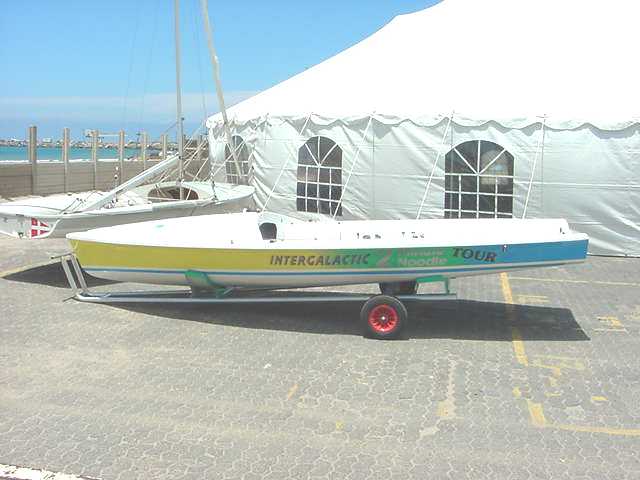
Nice colour scheme!
| On-Shore Images from the 2000 Worlds in Durban photos by Ali Meller,
Ebbe Rosen and Jesse Falsone Wishing to have the jet lag out of the way before sailing, and wanting to be on site for container customs clearance on Friday, I arrived in Durban a day or so early – Thursday noon. The Point Yacht Club beach site was quiet and calm before the onslaught of boats and competitors. The first container – Australian – was being unloaded. One of the local RSA teams was racing the Parker 25 that Krister Bergstrom and P. Anders Hallberg won the 1989 worlds in, 8211. Some of the Flying Dutchman sailors had gotten to Durban even earlier than me, and were rigging and practicing. The first few days were warm and sunny with light to medium winds. Launching into the Indian Ocean seemed easy, particularly since the launching beach was protected by a man-made reef. Peter Alarie and the John Fry entourage arrived on the same plane as I did; Howard Hamlin arrived the next day, and Howard/Peter got to work on Spaceman Spiff, which despite Peter's Tank Talk articles about not doing boat work at regattas, apparently needed some work. Speaking of doing work at the regatta site; Brett Van Munster arrived early with a yet-to-be-completed brand new Van Munster 505, and he and crew Adam Linton got to work fitting it out. Van Munster Shipwright & Boatbuildinghave been working on both the interior and hull moulds. The boat looked terrific. My understanding is that the Van Munster is a fully cored, vinylester boat. Apparently the cool colour schemes are included in the base price! |
|
Nigel Milln introduced me to my crew, Joe Boy, who turned out to be a VERY fit, VERY strong, VERY keen, VERY experienced, and most important, VERY tolerant crew; I could not have hoped for better. The Pre-Worlds Opening Ceremonies featured a wildly enthusiastic percussion group I ended up seeing/hearing them three times in three different locations; they were sort of a Durban theme for me. It turns out the pony-tailed guy in front also plays percussion in the Durban symphony orchestra. As you might expect a lot of activity centered on the Point Yacht club Beach Site bar. Brett Van Munster and Adam Linton appear to be taking a break from 505 rigging and are chatting up two event organizers (right photo). Brett is probably telling them how to make a drink called a Mutton Bird Repellent. Its a long story, but the Mutton Bird has an annoying tendency to fall out of the sky during its annual migration, and so one needs a repellant to protect oneself. Of course the ever thoughtful Aussie's have come up with one. I can attest that they go down very easily. Brett has provided the ingredients. The worlds opening ceremony featured a South African Navy band, a choir, the Kwazulu-Natal Minister of Sport giving a welcoming speech, several other speakers, Zulu dancers and more. |
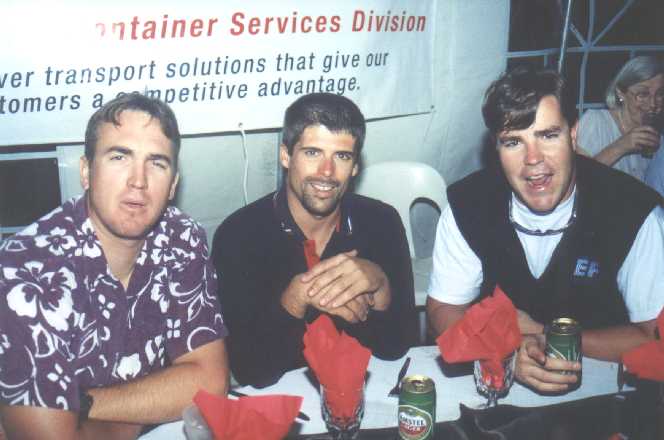
the boys – Andy Zinn, Andy Beeckman and Mike Welch –
enjoying themselves
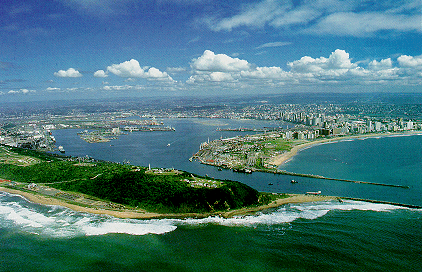
Port of Durban from the air
Great body surfing!
|
The view of the ocean from the Point Yacht Club beach site was mesmerizing; we got to see quite a bit of the Indian Ocean, both in nice sunny easy moments, and in moments when the power of the sea was incredible. Swimming and body surfing was great when it was not too windy. I wore a wetsuit the first day we sailed for practice, and never put it on again. Even the windiest, wildest days were so warm I was sailing in a Lyra suit and hiking pants. The locals sailed in shorts and maybe T-shirts. The strong offshore breeze on the days we did not race would blow fine sand very hard, so it was not comfortable in the water, on the beach or in the dinghy park. Despite being covered, the boats would have fine sand in them each morning. Measurement Day appeared to go smoothly, with local Mike Surgeson in charge, and the 505 class's Don O'Donnell there. Several times during the week I saw a group of very serious looking people trying to fit an FD centreboard inside an FD centreboard template, and I quietly thanked the people who set up the 505 class rules and who wrote them such that the board simply had to not stick out the bottom of the centreboard trunk. Can you imagine the hassle of having to remove your centreboard for measurement? Can you imagine not being able to experiment with different centreboards? As always seems to happen, once the competitors arrive and it is time to start racing, conditions become quite abnormal – "It's never like this here!" Durban's great warm, sunny, easy weather got windier. After some light practice days, we went out for day one of the pre-worlds. The light breeze first died to nothing, and then started to fill in big time. The race started in 20+ knots and built from there. You can read the pre-worlds day one press release, but the bottom line is that only 18 505s and 2 Flying Dutchman finished the one race, and both the 505 and FD fleets struggled ashore in steady 42 knots with puffs to 50. This is extreme even before you consider the waves and swells. If someone had asked me beforehand if it was possible to sail a 505 in 42-50 knots, I would have said no, but the fleet proved it was doable. Something like 17 masts were broken between both fleets and three 505s had to be abandoned. One sank and the other two came ashore to the north, in little pieces. It was not possible to tow a boat unless it was upright in these conditions, and getting a powerboat alongside a swamped 505 would take some doing in those seas. |
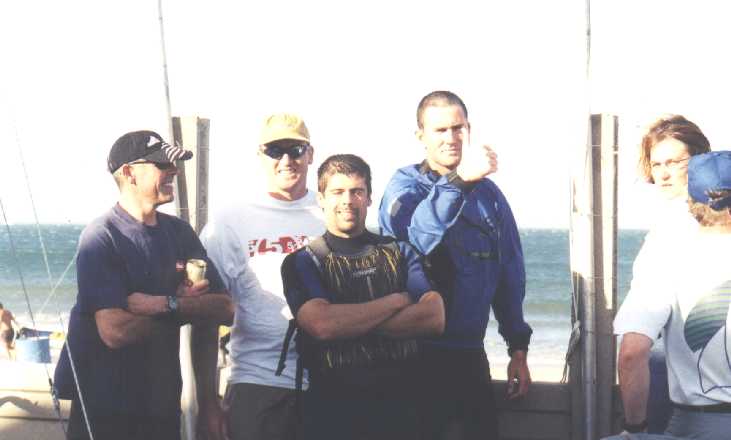
The "Young Bucs" are VERY pleased to be ashore
|
The FD course was close to the launching beach, while the 505 course was several miles further away (north along the coast and more offshore) to conform to the 505 Class Worlds course guidelines. This meant that the 505 sailors struggling in after this pre-worlds race had a five mile sail dead upwind to get back to the launching beach next to the Point Yacht Club beach site. Think about it – five miles in 42-50 knots and huge seas. While I didn't have a lot of time to think – I was focusing on getting the boat over the next wave – it did occur to me while sailing, that John Westell designed an incredible boat. One of the conclusions I reached while sailing back was that John Westell is a god. A later conclusion reached on shore as it became apparent that most people were OK, was that the fleet probably demonstrated a very high standard of seamanship; I believe most teams got their boats back to shore themselves. For those of you who were not there, I rather doubt any of us are going to be able to describe the conditions such that you will completely understand what they were like. |
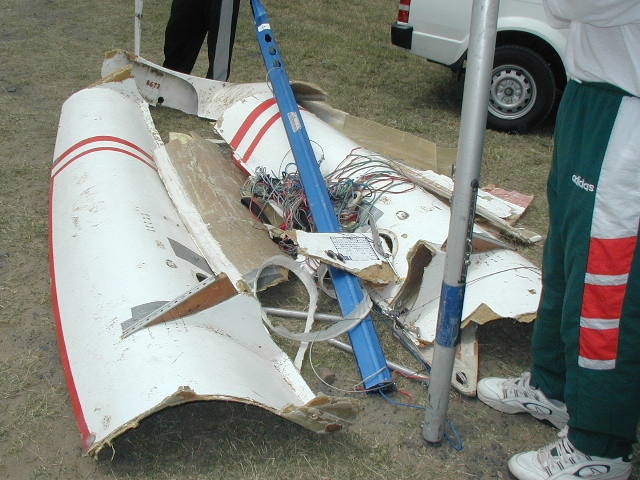
What was left of 8672? after it washed ashore

No worries mate; we can fix it!
|
The above picture is one of the larger remaining pieces from a nearly new Australian 505 that came ashore 50 kilometers north, several days after it had to be abandoned after pre-worlds race one. The next two days of the pre-worlds were blown out, so we only had the one race to count, but then the warm lighter conditions returned for the measurement day. Bruce Edwards/Dave Shelton from Santa Cruz had won that one race and got a trophy for it at the pre-worlds prize presentation/worlds opening ceremony. The two days off were used to good effect by those fixing boats, rigging new masts, and having sails repaired. Race one of the worlds had nice conditions, and was won by Howard Hamlin/Peter Alarie after they lost a nice lead to Krister Bergstrom/Thomas Moss, dueled most of the way up the last beat, and past him in the last tacks for the finish. The strong offshore winds returned after that and we spent the next four days ashore waiting for conditions to be reasonable. Though at times it might have looked sailable from the shore, it was typically blowing 35-40 knots, with large breaking seas on the 505 course. The wind was offshore, so anyone with a breakdown would be drifting out out to sea. The view was spectacular at times. You could look downwind and see breaking waves; it would look similar to 15-20 knots looking upwind. The RC would send boats out to check on conditions and they would report very high winds and incredible sea conditions. |

Peter Alarie and Howard Hamlin, in the lead and waiting
|
A number of social events were on the schedule, on of which was a very nice reception hosted by the Mayor of Durban, at the Durban city hall. This included copious amounts of food, wine and beer, which we were strongly encouraged to finish. For the next four days, Howard and Peter were leading the 2000 Worlds, as they had won the only race held. Meanwhile everyone would show up at the club in the morning, check the weather and look at the waves, check the forecast on the web – how can we have so many lows lined up like this – shake their heads, and then wait for the RC to abandon for the day. So what do you do when racing is being blown off day after day? Well, one option is to go surfing. It appears that some members of the 505 class are pretty good at it, and were hot dogging it on the surfing beach. When they abandoned early, everyone would disappear and head out to see some Durban attractions, but as the days went by, competitors and the RC preferred to wait just in case the wind abated and we could sail in the afternoon. We also held the 505 class Annual Meeting early during one of these postponements. Most competitors were staying at the Tropicana or the Holiday Inn next door. Both are just across the street from the beach, and a nice walk along the beach away from the sailing site. |
|
The 505 Class Annual Meeting went well, perhaps the most interesting thing being the vote in favour of the long luff spinnaker. This was introduced as two votes to change two class rules. The first was the spinnaker dimensions, and the second was the maximum spinnaker halyard height on the mast. In the discussion preceding the vote, no one at the meeting cared to speak against the change, and indeed all votes were in favour; no "no" votes were made, on both the changes. A report on progress on the 2001 Worlds in Cascais, Portugal was given, as were reports on the 2002 Worlds in Freemantle, Australia, and the 2003 Worlds in Malmo, Sweden. Bruce Edwards addressed the meeting regarding a proposal to hold the 2004 Worlds in San Francisco Bay. The IEC also mentioned the idea of holding the 2006 World Championship (the 50th 505 world championship) in England, perhaps at Mount's Bay. Another possible venue for the 2004 Worlds, Bermuda, was also mentioned.
The formal part of the AGM was followed by an open class forum, where a number of ideas were discussed and some voted on. Again, read the report for the details, but the class will be trialing carbon fibre spars, and may look at changing our worlds courses and worlds scoring. |

The Internet cafe, no food, drink or pornography allowed
|
The eight PCs in the Internet Cafe (left) were so much in demand competitors were lining up for them. After several days a competitors-and-RC meeting (right) was held to discuss the situation. Having the two courses (21 FDs on the near course, and 62 or so 505s on the far course) was stretching the limited people and resources available, and the very strong offshore breezes and enormous seas made it very risky to launch and sail. For that matter, getting off the beach was a challenge! Various alternatives were discussed, including combining the two classes on one course. The two following days where we did race were not windy enough for this option to be used. Competitors hung out and chatted through postponements, but each day the racing was cancelled. Eventually, after four days of cancellation, the wind abated and we sailed two races in light to medium conditions and large swells and waves. Mike Martin/Steve Bourdow won both, to take the overall lead from Howard/Peter, with Krister Bergstrom/Thomas Moss in third. All three teams were within one point, with Barker/Cripps not far behind them in fourth. |
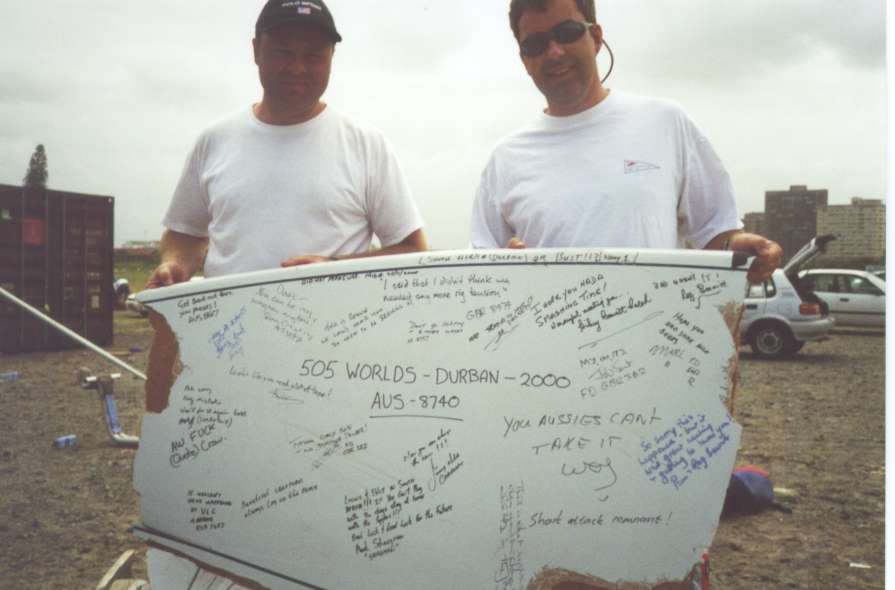
8740 did not survive the first pre-worlds race
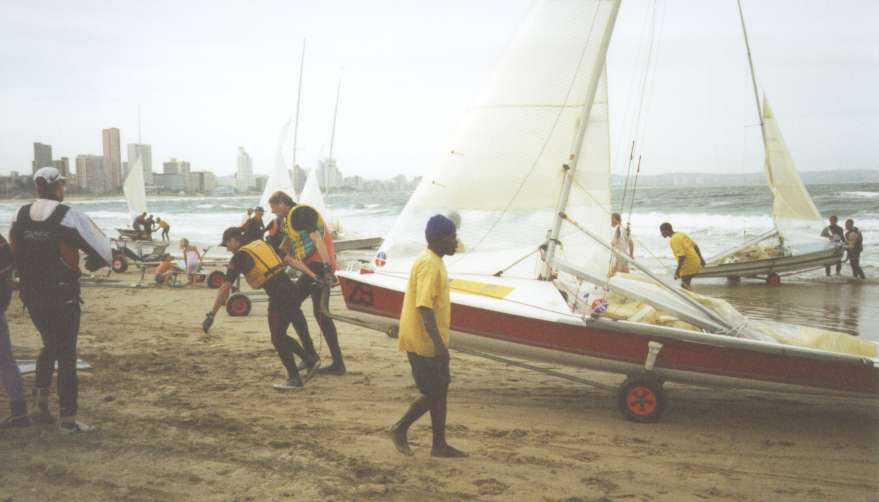
Simon Payne and Bill Masterman haul Gus up the beach
|
The next day was windier, in the 16-24 knot range, and Krister Bergstrom/Thomas Moss demonstrated clearly superior upwind speed to control both races from the start, around the course to the finish line. Martin/Bourdow went 4,3, Hamlin/Martin were 5,4, Barker/Cripps 2,6, while Ian Pinnell/Nick Powell had the second best day with a 3,2. This put Bergstrom/Moss in the lead, though with one race to go Mike Martin/Steve Bourdow could still catch them. |
|
The expected final race showdown never happened, as conditions were once again too extreme to launch and sail, and racing was cancelled, leaving us with a five race series. |
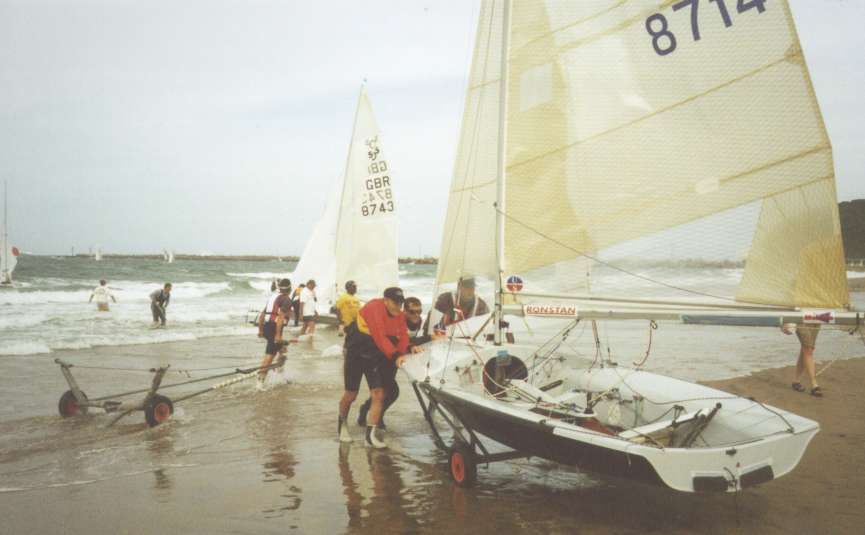
8714 being retrieved from the beach
|
This result gave the 2000 International 505 World Championship title to Krister Bergstrom and Thomas Moss. With finishes of 2, 4, 2, 1, 1, they threw out a 4th! This is the fifth 505 World Championship for Krister, he also won in 1987, '88, '89 (three in a row) and again in 1991. Having past the great Peter Colclough in number of 505 World Championships, Krister is now known as "God" within the 505 worlds fleet. |
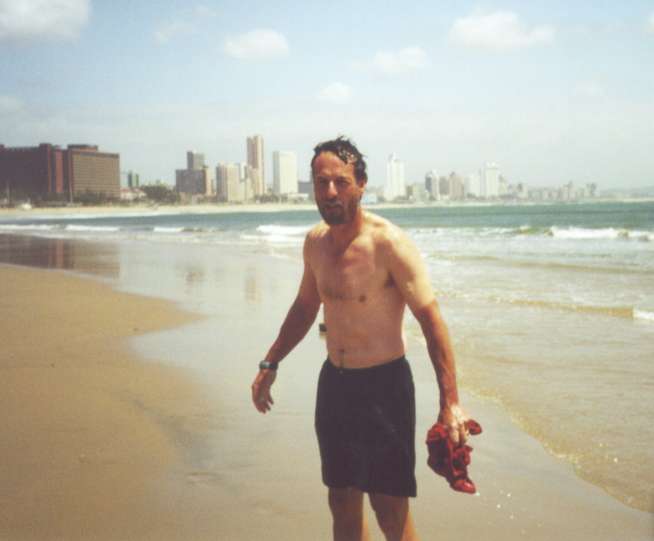
Krister Bergstrom after being thrown in
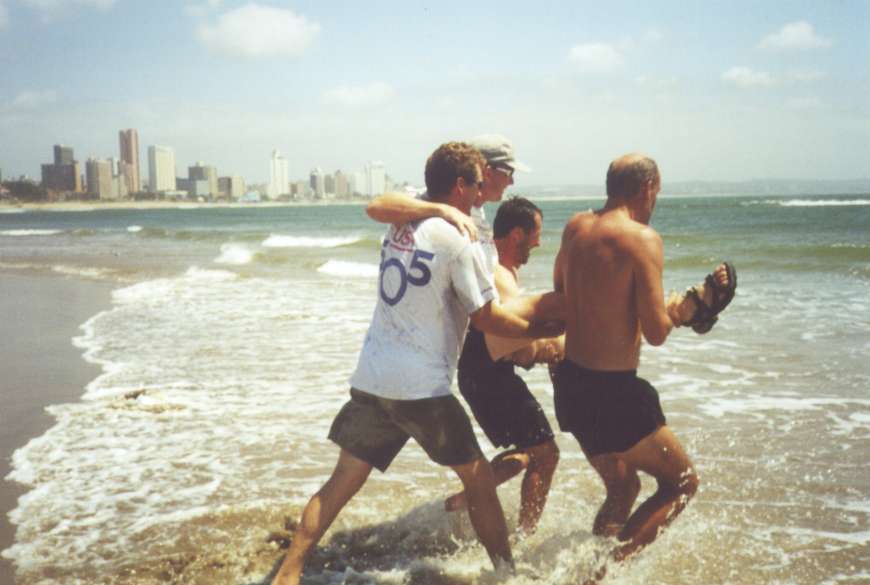
This doesn't look good for Thomas Moss!
|
Krister and Thomas have been racing together for six years and have narrowly missed out on several world championships in that time, finishing second by about a point in 1995, and leading going into the last race in '96. It appears that for much of that time they were working hard at development and tuning and it finally paid off for them. Perhaps the most amazing aspect is that Krister and Thomas have been doing this by themselves; they have no local tuning partners, but can only test speed when someone travels so that two boats sail together. In contrast, the second, third, sixth and thirteenth place finishers were all members of "Team Tuesday" the Long Beach group that train together every Tuesday evening. |
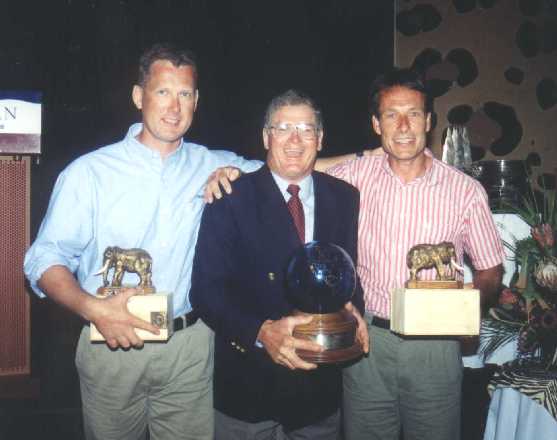
2000 505 World Champions Thomas Moss and Krister Bergstrom,
with 505 class President, Pip Pearson
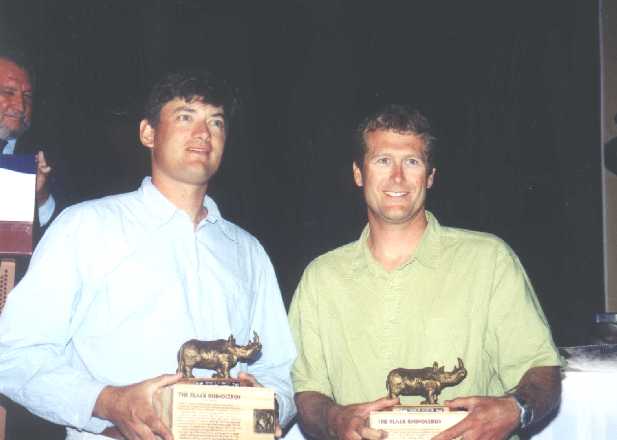
2nd place, 1999 World Champion crew (now driving) Mike Martin,
and FD silver medalist and two time FD world champion, Steve Bourdow
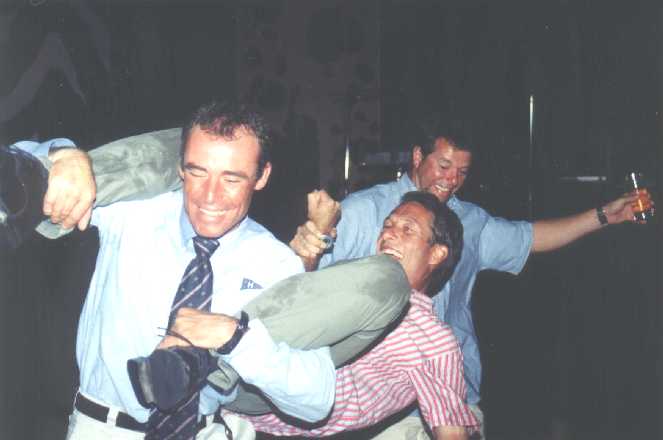
Krister seems resigned to his fate
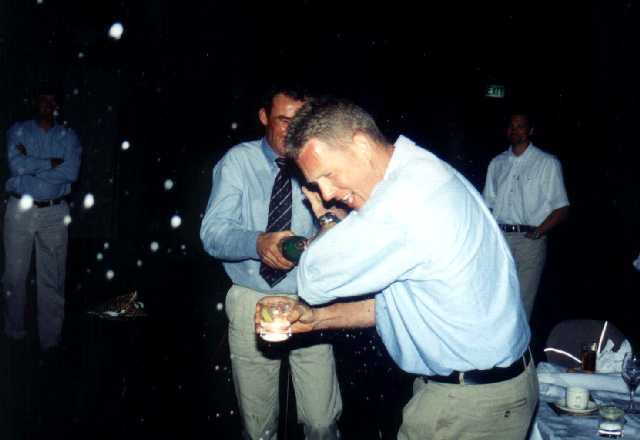
Direct hit on Thomas, and the camera!
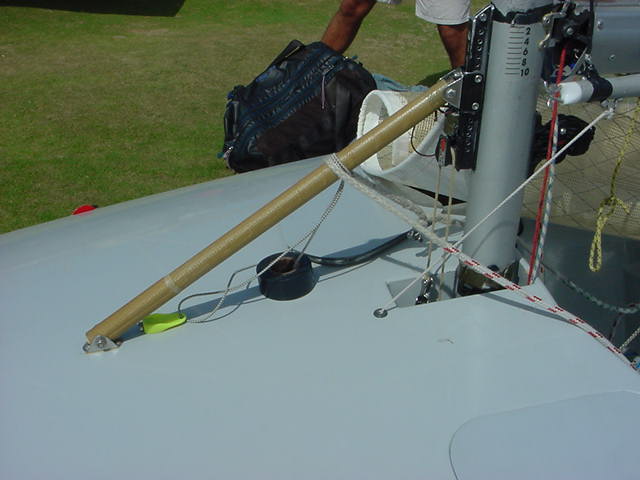
Mike Martin's Kevlar/carbon mast ram
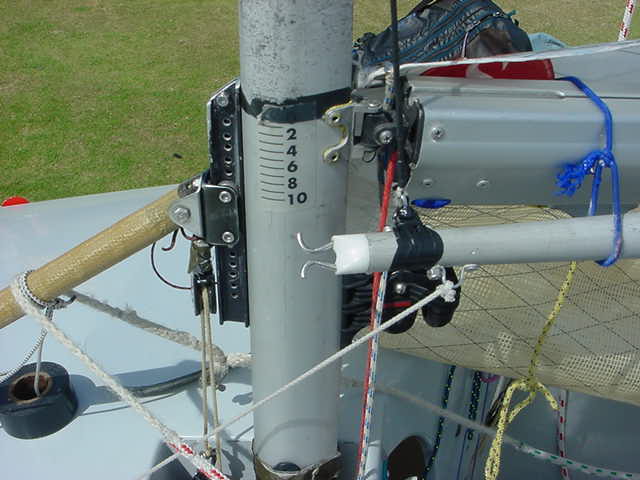
Mike Martin's version of the fork end
|
One of the most interesting aspects of this championship is what happened on the last day as it became clear that there would be no 6th race. A photographer – Roy Dunster – and I were taking photographs for an upcoming Sailing World article on 505 worlds gear. Several of the top boats were photographed, measured, and rolled over and their centreboards revealed. Krister Bergstrom was using a home made board with a much lower area and higher aspect ratio than anyone else. He was also using a Proctor cumulus mast instead of the D. Some of this will be in the Sailing World article, but in the meantime... Krister took the board he used in
Gilleleje, and lengthened it by approximately six inches, making it merely very small
instead of nearly rudder sized. He has added a third bailer aft of the other two, to bail
the stern when the boat is planing fast. Most control systems are in the middle of the
boat to concentrate the weight, and he has added considerable structure to the boat over
the past few years. Mutton Bird RepellentThanks to Brett Van Munster for providing this recipe. — www. int505.se — Uppdaterad 2020-02-15
|